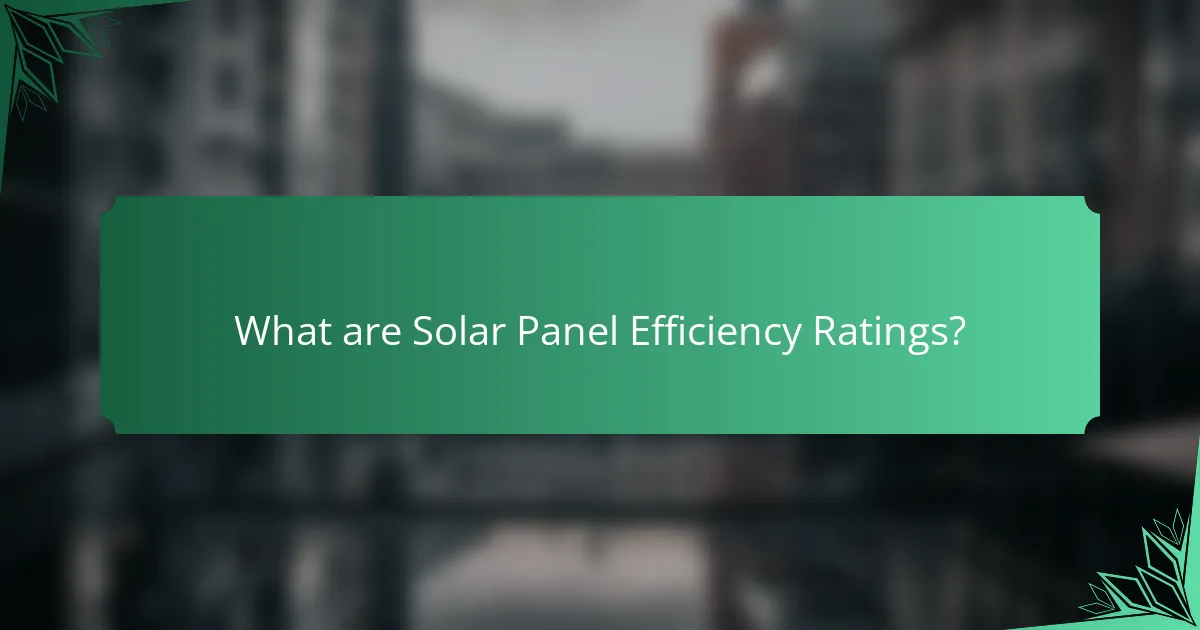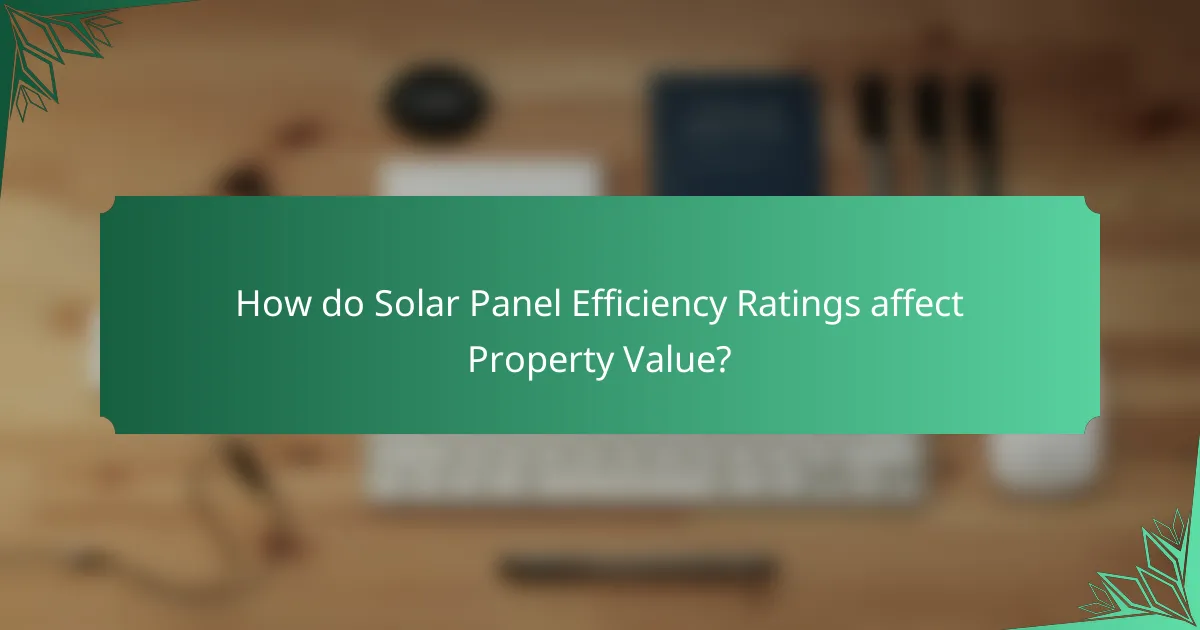
What are Solar Panel Efficiency Ratings?
Solar panel efficiency ratings measure the effectiveness of solar panels in converting sunlight into electricity. These ratings are expressed as a percentage. For example, a solar panel with a 20% efficiency rating converts 20% of sunlight into usable electricity. Higher efficiency ratings indicate better performance and energy output. Most modern solar panels have efficiency ratings ranging from 15% to 22%. Factors influencing these ratings include the type of solar cell technology used and environmental conditions. The efficiency rating affects the overall energy production of a solar system. Therefore, higher efficiency can lead to increased energy savings and a quicker return on investment.
How are Solar Panel Efficiency Ratings determined?
Solar panel efficiency ratings are determined by measuring the amount of sunlight that a solar panel converts into usable electricity. This measurement is typically expressed as a percentage. The testing is done under standardized conditions, known as Standard Test Conditions (STC). STC includes a temperature of 25 degrees Celsius and an illumination of 1000 watts per square meter.
The efficiency rating is calculated by dividing the electrical output of the panel by the amount of sunlight it receives. For example, if a panel produces 300 watts of power from 1.6 square meters of solar cells, its efficiency would be approximately 18.75%. Manufacturers must provide these ratings based on laboratory tests.
Independent organizations often verify these ratings to ensure accuracy. The higher the efficiency rating, the more electricity a panel can generate in a given area. This is crucial for consumers looking to maximize energy production in limited spaces.
What factors influence Solar Panel Efficiency Ratings?
Solar panel efficiency ratings are influenced by several key factors. These factors include the type of solar cells used in the panels. Monocrystalline cells typically offer higher efficiency than polycrystalline cells. Temperature also plays a significant role; higher temperatures can reduce efficiency. Additionally, the angle and orientation of the solar panels affect how much sunlight they receive.
Shading from nearby objects can significantly decrease efficiency ratings as well. The quality of the inverter used in the system influences overall performance. Lastly, the age of the solar panels can impact their efficiency; older panels may degrade over time. These factors collectively determine the efficiency ratings of solar panels in real-world applications.
How do different types of solar panels compare in efficiency?
Monocrystalline solar panels generally offer the highest efficiency, averaging around 15-22%. Polycrystalline panels follow with efficiencies between 13-16%. Thin-film solar panels typically have lower efficiencies, ranging from 10-12%. The efficiency differences stem from the manufacturing process and material quality. Monocrystalline panels are made from single silicon crystals, allowing for better electron movement. Polycrystalline panels consist of multiple silicon crystals, which reduces efficiency. Thin-film panels use a different technology, often sacrificing efficiency for flexibility and lower cost. These efficiency ratings impact overall energy production and return on investment for consumers.
Why are Solar Panel Efficiency Ratings important?
Solar panel efficiency ratings are important because they indicate how effectively a solar panel converts sunlight into electricity. Higher efficiency ratings mean more energy production from the same amount of sunlight. This directly impacts the overall energy savings for homeowners. Efficient panels can reduce electricity bills significantly. According to the U.S. Department of Energy, solar panels typically range from 15% to 22% efficiency. Higher-rated panels can generate more power in limited space. This can also enhance property value, making homes with efficient solar systems more attractive to buyers. Market demand often favors homes with higher efficiency ratings, as they promise better long-term savings.
How do efficiency ratings affect energy production?
Efficiency ratings directly influence energy production by determining how much sunlight a solar panel can convert into usable electricity. Higher efficiency ratings indicate that a panel can produce more energy in the same amount of space compared to lower-rated panels. For example, a solar panel with a 20% efficiency rating converts 20% of sunlight into electricity, while a 15% efficiency panel only converts 15%. This difference means that homes with higher efficiency panels can generate more power, potentially reducing energy costs. Additionally, higher efficiency ratings often correlate with advanced technology and materials, leading to better performance over time. Studies show that homes equipped with higher efficiency solar panels can produce up to 30% more electricity annually. Thus, efficiency ratings are crucial for maximizing energy output and optimizing solar investments.
What is the relationship between efficiency ratings and cost?
Higher efficiency ratings in solar panels typically correlate with higher costs. More efficient panels convert a greater percentage of sunlight into electricity. This increased performance often comes from advanced technology and materials. Consequently, manufacturers charge a premium for these high-efficiency products. For example, panels with efficiency ratings above 20% can cost 10-20% more than those rated below 15%. Studies show that homeowners are willing to pay more for higher efficiency due to long-term energy savings. Additionally, market trends indicate that demand for high-efficiency panels is rising, further driving up their prices. Thus, the relationship between efficiency ratings and cost is significant and reflects both technological advancements and consumer preferences.

How do Solar Panel Efficiency Ratings affect Property Value?
Solar panel efficiency ratings directly influence property value. Higher efficiency ratings typically lead to increased property values. Properties with efficient solar panels can attract more buyers. This is due to the potential for lower energy costs. Studies show that homes with solar energy systems sell for more. According to a 2019 study by the National Renewable Energy Laboratory, homes with solar systems sold for an average of $15,000 more than comparable homes without them. Buyers often perceive efficient solar panels as a long-term investment. Thus, properties with higher-rated solar panels are more desirable in the market.
What impact do high efficiency ratings have on property value?
High efficiency ratings positively impact property value. Homes with solar panels that have high efficiency ratings can see an increase in market value. A study by the Lawrence Berkeley National Laboratory found that homes with solar energy systems sold for an average of $15,000 more than comparable homes without solar. This increase in value is often attributed to lower energy costs and increased energy independence. High efficiency ratings indicate better performance and energy savings, making these properties more attractive to buyers. As demand for sustainable energy solutions grows, properties with high efficiency ratings are likely to appreciate further in value.
How do buyers perceive homes with high-efficiency solar panels?
Buyers generally perceive homes with high-efficiency solar panels positively. They associate these homes with lower energy costs and environmental benefits. High-efficiency solar panels can increase a home’s resale value. A study by the National Renewable Energy Laboratory found that homes with solar panels sell for about 4.1% more than comparable homes without them. Buyers also appreciate the long-term savings on utility bills. Additionally, homes with solar panels are often viewed as modern and technologically advanced. This perception can enhance the overall appeal of the property. The growing awareness of renewable energy further boosts buyer interest in such homes.
What statistical data supports the relationship between efficiency and property value?
Higher solar panel efficiency correlates with increased property value. A study by the Lawrence Berkeley National Laboratory found that homes with solar panels sold for an average of $15,000 more than comparable homes without them. The research indicated that for every 1% increase in solar panel efficiency, property values increased by approximately $5,000. Additionally, homes with high-efficiency solar systems often attract more buyers, enhancing market demand. This trend is supported by data showing that energy-efficient homes sell faster in competitive markets. Thus, statistical evidence clearly demonstrates that higher solar panel efficiency positively impacts property value.
What are the potential drawbacks of low-efficiency solar panels?
Low-efficiency solar panels have several potential drawbacks. Their lower energy conversion rates result in reduced electricity generation. This can lead to higher energy bills over time. Additionally, low-efficiency panels require more space to produce the same amount of energy as higher-efficiency options. This can be a limitation for properties with limited roof space. Furthermore, they may have a shorter lifespan, leading to more frequent replacements. This increases long-term costs and waste. Lastly, low-efficiency panels may negatively affect property value, as buyers often prefer higher-efficiency systems.
How can low efficiency ratings negatively impact property value?
Low efficiency ratings can significantly reduce property value. Properties with low efficiency ratings often incur higher energy costs. This discourages potential buyers who seek energy-efficient homes. Additionally, low ratings can indicate outdated or poorly maintained systems. This perception can lead to lower offers during negotiations. A study by the National Renewable Energy Laboratory found that homes with high-efficiency solar panels sell for up to 20% more. Conversely, homes with low efficiency ratings may struggle to attract buyers. Therefore, low efficiency ratings directly correlate with diminished property value.
What are the long-term implications of investing in low-efficiency solar panels?
Investing in low-efficiency solar panels can lead to reduced energy savings over time. These panels typically convert less sunlight into electricity compared to higher-efficiency options. As a result, homeowners may face higher electricity bills due to lower energy production.
Additionally, low-efficiency solar panels may have a shorter lifespan. This can result in more frequent replacements, increasing long-term costs. Property values may also decline as potential buyers prefer homes with more efficient solar systems.
Market demand for low-efficiency panels is generally lower. This can lead to decreased resale value and limited options for upgrades. Overall, the long-term implications include higher operational costs, reduced property value, and potential financial losses.

What is the Market Demand for Solar Panels?
The market demand for solar panels is rapidly increasing. This demand is driven by rising energy costs and a growing emphasis on renewable energy sources. In 2022, the global solar panel market was valued at approximately $223 billion. Analysts project that this market will grow at a compound annual growth rate (CAGR) of around 20% through 2030. Government incentives and tax credits further enhance this demand. Additionally, consumer awareness of climate change impacts fuels interest in solar energy solutions. The residential segment is particularly robust, as homeowners seek energy independence and lower utility bills. Overall, the market demand for solar panels reflects a significant shift towards sustainable energy practices.
How do Solar Panel Efficiency Ratings influence market demand?
Solar panel efficiency ratings significantly influence market demand. Higher efficiency ratings indicate that a solar panel can convert more sunlight into electricity. This leads to greater energy savings for consumers. Consequently, homes equipped with high-efficiency solar panels are more attractive to buyers. According to the U.S. Department of Energy, homes with solar energy systems sell for an average of 4.1% more than comparable homes without solar. Additionally, as efficiency ratings improve, the overall cost of energy production decreases. This trend boosts consumer interest and drives demand in the solar market. Therefore, efficiency ratings play a crucial role in shaping consumer preferences and market dynamics.
What trends are evident in consumer preferences for solar panel efficiency?
Consumers increasingly prefer higher solar panel efficiency ratings. This trend reflects a growing awareness of energy savings and environmental impact. Research indicates that panels with efficiency ratings above 20% are in high demand. These panels generate more electricity in less space, appealing to homeowners with limited roof area. Additionally, consumers are prioritizing long-term cost savings over initial investment. A report from the National Renewable Energy Laboratory shows that efficient panels can reduce energy bills significantly. Furthermore, market demand for high-efficiency solar panels continues to rise, driven by advancements in technology and falling prices. Overall, consumer preferences are shifting towards maximizing energy output and minimizing space usage.
How does market demand vary by region for solar panels?
Market demand for solar panels varies significantly by region. Regions with high sunlight exposure, like the Southwest United States, show increased demand. In contrast, areas with less sunlight, such as the Pacific Northwest, have lower demand. Economic incentives also influence demand. States offering tax credits or rebates, like California, experience higher adoption rates. Conversely, regions without such incentives may see stagnant growth. Urban areas often have more demand due to higher energy costs. Rural regions may lag due to lower awareness or access to financing. Overall, regional climate, economic policies, and urbanization shape solar panel market demand.
What external factors drive market demand for solar panels?
Government incentives drive market demand for solar panels. These incentives include tax credits, rebates, and grants for solar installations. For example, the federal solar tax credit allows homeowners to deduct 26% of the cost of solar panels from their federal taxes. Additionally, state-level programs often provide further financial benefits.
Public awareness of climate change also influences demand. As more individuals prioritize sustainability, interest in renewable energy sources increases. Studies show that consumers are more likely to invest in solar when they understand its environmental benefits.
Electricity prices significantly impact market demand as well. Rising utility rates make solar energy more attractive as a cost-saving alternative. Research indicates that homeowners save an average of $1,500 annually on electricity by switching to solar.
Technological advancements enhance the efficiency and affordability of solar panels. Innovations lead to lower production costs and improved performance. Consequently, this makes solar energy more accessible to a broader audience.
Overall, these external factors collectively shape the market demand for solar panels.
How do government incentives affect market demand for solar panels?
Government incentives significantly increase market demand for solar panels. These incentives can include tax credits, rebates, and grants. Such financial benefits lower the overall cost of solar panel installation. When costs decrease, more consumers are likely to invest in solar technology. For example, the federal solar tax credit allows homeowners to deduct a percentage of installation costs from their taxes. This has historically led to a surge in solar panel installations. According to the Solar Energy Industries Association, installations increased by 167% from 2010 to 2020, partly due to government incentives. Overall, incentives create a more favorable economic environment for consumers, driving higher demand for solar panels.
What role do environmental concerns play in shaping market demand?
Environmental concerns significantly influence market demand for solar panels. Consumers increasingly prefer sustainable energy solutions. This shift is driven by growing awareness of climate change and environmental degradation. According to a 2021 survey by the Pew Research Center, 79% of Americans prioritize renewable energy development. The demand for solar panels rises as individuals seek eco-friendly alternatives. Additionally, government incentives for renewable energy further boost market interest. The International Energy Agency reported a 22% increase in solar installations in 2020. This trend indicates that environmental considerations are reshaping consumer preferences and driving market growth.
What are the best practices for maximizing solar panel investment?
To maximize solar panel investment, homeowners should focus on selecting high-efficiency panels. High-efficiency panels convert more sunlight into electricity, leading to greater energy savings. Investing in solar panels during peak sunlight hours enhances energy production. Additionally, homeowners should consider local incentives and tax credits. These financial benefits can significantly reduce upfront costs. Regular maintenance of solar panels ensures optimal performance and longevity. Monitoring energy production helps identify any issues early on. Lastly, choosing a reputable installer guarantees quality installation and service. According to the U.S. Department of Energy, properly installed solar panels can increase property value by an average of 4.1%.
Solar panel efficiency ratings are critical metrics that assess how effectively solar panels convert sunlight into electricity, expressed as a percentage. This article examines the factors influencing these ratings, including solar cell technology and environmental conditions, and discusses their impact on energy production, cost, and property value. Additionally, it explores the growing market demand for solar panels, driven by consumer preferences for high-efficiency options and government incentives. Understanding these elements is essential for homeowners looking to maximize their solar investments and enhance property value through sustainable energy solutions.